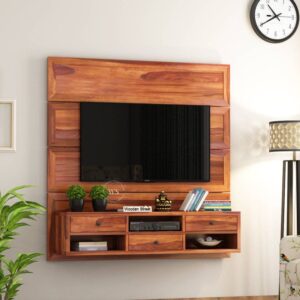In modern homes, a wall mounted TV unit has evolved far beyond its functional role of holding a television. It now serves as a key element in living room design, seamlessly combining aesthetics, functionality, and smart storage. As homeowners increasingly prefer sleek and minimal setups, wall mounted TV units have become essential for creating an organized and visually appealing entertainment area. This article explores a range of design ideas that help you strike the perfect balance between style and storage, ensuring that your space looks sophisticated while remaining practical.
1. The Importance of Design Balance
When choosing a wall mounted TV unit, balancing style with functionality is essential. A well-designed unit should complement the overall décor of the room while efficiently accommodating media essentials such as cables, speakers, and set-top boxes. Modern designs focus on clean lines, minimal clutter, and innovative storage solutions. The aim is to create a streamlined look where the TV unit enhances the room’s ambiance rather than overwhelming it. By thoughtfully combining open shelves, hidden cabinets, and decorative accents, you can achieve a harmonious balance that reflects both elegance and utility.
2. Floating TV Units for Minimalist Spaces
Floating TV units have gained popularity due to their sleek and space-saving appeal. Mounted directly on the wall, they create a floating effect that gives the room a light and airy feel. These units are perfect for contemporary interiors where minimalism takes center stage. A floating unit can include discreet drawers for storing remotes, gaming consoles, or DVDs, maintaining a clean look. Using neutral colors such as white, beige, or grey enhances the minimalist aesthetic, while backlighting or LED strips can add a subtle glow that highlights the wall area behind the TV.
3. Integrating Storage Smartly
Effective storage design is key to the success of a wall mounted TV unit. Open shelving allows you to display décor pieces, books, or photo frames, while closed cabinets keep clutter out of sight. For compact living rooms, modular storage systems work best, allowing you to customize compartments as per your needs. Incorporating vertical storage around the TV can maximize wall space without crowding the floor. Some homeowners even choose units with sliding panels or foldable doors that offer flexibility and conceal equipment when not in use. The idea is to blend storage seamlessly into the unit without disrupting its aesthetic appeal.
4. Material Choices That Define Character
The choice of material significantly influences both the style and durability of a wall mounted TV unit. Wooden finishes bring warmth and texture to a living room, making them ideal for cozy and natural-themed interiors. Engineered wood or laminate options offer a balance between affordability and visual charm, while glossy finishes in MDF or acrylic give a modern, polished look. Metal and glass combinations are also trending for industrial and contemporary setups. When selecting materials, consider the existing furniture, flooring, and wall color to ensure cohesion in design.
5. Incorporating Decorative Elements
A wall mounted TV unit should not only serve as a functional piece but also as a decorative feature in the room. Incorporating artwork, plants, and accent lighting can elevate the visual appeal. Floating shelves around the TV can hold collectibles or framed photographs, turning the unit into a personalized display area. Using contrasting colors or textural backgrounds, such as wood panels or stone cladding, adds depth to the design. The key is moderation — too many decorative elements can clutter the visual space and distract from the focal point, which is the TV itself.
6. Maximizing Space in Large Living Rooms
For spacious living areas, a wall mounted TV unit can act as the centerpiece of the room. Opting for a big-sized unit with symmetrical cabinets and wide shelving creates a balanced, luxurious look. Long units that stretch across the wall can also double as display surfaces for décor items. In larger spaces, the inclusion of vertical storage or tall side units adds dimension while filling up empty wall areas effectively. Choosing the right proportion and placement ensures that the TV unit anchors the room harmoniously without dominating it.
7. Blending Technology with Design
As entertainment systems become more advanced, integrating technology seamlessly into design is essential. Concealed cable management systems ensure that wires remain hidden, maintaining a neat appearance. Built-in spaces for soundbars, speakers, or gaming consoles make the unit both practical and stylish. Some high-end designs even incorporate motion-sensor lighting or hidden compartments for additional gadgets. This approach keeps the setup clean, organized, and future-ready.
8. Matching the Unit with Overall Décor
A wall mounted TV unit should align with the broader design language of your home. In a modern living room, opt for glossy finishes and geometric lines, whereas rustic spaces can benefit from natural wood tones. Scandinavian-inspired interiors look best with light-colored wood and white surfaces, while industrial homes might prefer metal frames and darker shades. The goal is to create a cohesive design flow where every element complements the others, from the sofa and coffee table to the lighting and wall colors.
Conclusion
A well-designed wall mounted TV unit is more than a functional necessity — it’s a statement of modern living. By focusing on balance, homeowners can enjoy a setup that merges style with smart storage, creating a clean and elegant entertainment area. From floating units and modular systems to decorative accents and integrated technology, there are endless ways to design a unit that meets both aesthetic and practical needs. The key is thoughtful planning and quality craftsmanship, ensuring your TV unit remains a timeless feature that enhances your home’s beauty and efficiency for years to come.







